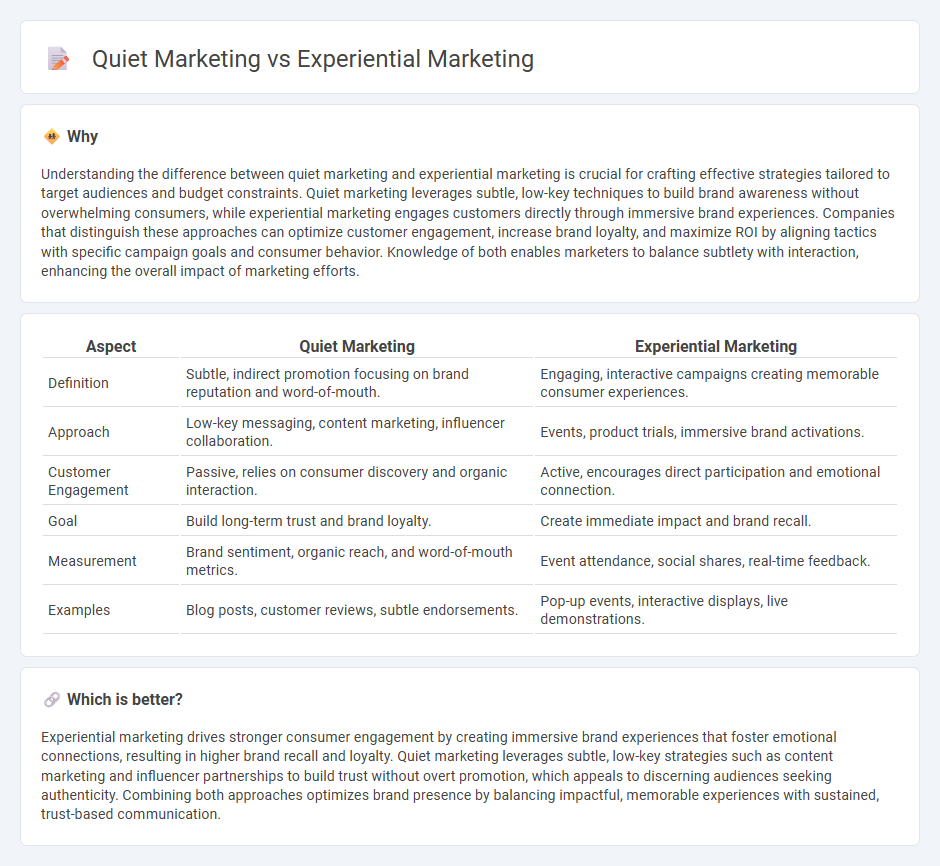
Quiet marketing focuses on subtle, low-key strategies such as word-of-mouth, content marketing, and brand storytelling to build long-term customer relationships without aggressive promotions. Experiential marketing engages consumers through immersive, interactive events and brand experiences designed to create memorable emotional connections. Explore the unique benefits and applications of quiet versus experiential marketing to enhance your brand strategy.
Why it is important
Understanding the difference between quiet marketing and experiential marketing is crucial for crafting effective strategies tailored to target audiences and budget constraints. Quiet marketing leverages subtle, low-key techniques to build brand awareness without overwhelming consumers, while experiential marketing engages customers directly through immersive brand experiences. Companies that distinguish these approaches can optimize customer engagement, increase brand loyalty, and maximize ROI by aligning tactics with specific campaign goals and consumer behavior. Knowledge of both enables marketers to balance subtlety with interaction, enhancing the overall impact of marketing efforts.
Comparison Table
| Aspect | Quiet Marketing | Experiential Marketing |
|---|---|---|
| Definition | Subtle, indirect promotion focusing on brand reputation and word-of-mouth. | Engaging, interactive campaigns creating memorable consumer experiences. |
| Approach | Low-key messaging, content marketing, influencer collaboration. | Events, product trials, immersive brand activations. |
| Customer Engagement | Passive, relies on consumer discovery and organic interaction. | Active, encourages direct participation and emotional connection. |
| Goal | Build long-term trust and brand loyalty. | Create immediate impact and brand recall. |
| Measurement | Brand sentiment, organic reach, and word-of-mouth metrics. | Event attendance, social shares, real-time feedback. |
| Examples | Blog posts, customer reviews, subtle endorsements. | Pop-up events, interactive displays, live demonstrations. |
Which is better?
Experiential marketing drives stronger consumer engagement by creating immersive brand experiences that foster emotional connections, resulting in higher brand recall and loyalty. Quiet marketing leverages subtle, low-key strategies such as content marketing and influencer partnerships to build trust without overt promotion, which appeals to discerning audiences seeking authenticity. Combining both approaches optimizes brand presence by balancing impactful, memorable experiences with sustained, trust-based communication.
Connection
Quiet marketing and experiential marketing both emphasize creating impactful customer experiences without overt advertising. Quiet marketing uses subtle, low-key tactics that build trust and brand loyalty, while experiential marketing engages consumers through immersive, memorable interactions. Together, they foster deeper emotional connections by blending discreet messaging with firsthand brand experiences.
Key Terms
Experiential marketing:
Experiential marketing creates immersive brand experiences that engage consumers through interactive events, product demonstrations, and sensory stimuli, driving emotional connections and memorable interactions. This strategy enhances brand loyalty and word-of-mouth by allowing customers to actively participate and form personal attachments to the brand. Discover how experiential marketing can transform customer engagement and boost your brand impact.
Engagement
Experiential marketing creates immersive brand experiences that actively engage consumers through interactive events and sensory stimuli, enhancing emotional connections and driving brand loyalty. Quiet marketing leverages subtle, low-key strategies like product placements, influencer endorsements, and discreet advertising to build trust without overt promotion. Discover how both approaches can uniquely amplify engagement and elevate your marketing strategy.
Immersion
Experiential marketing immerses consumers through interactive events and sensory engagement, fostering strong emotional connections and brand loyalty. Quiet marketing relies on subtle, low-profile tactics that prioritize brand presence without overwhelming the audience, creating a sense of exclusivity. Explore the impact of immersive strategies versus understated approaches to elevate your marketing effectiveness.
Source and External Links
Experiential Marketing: Creating Lasting Audience Connections - Bevy - Experiential marketing immerses customers in a brand's world by engaging all five senses, creating interactive and memorable experiences that build lasting relationships and loyalty beyond the campaign.
What is experiential marketing? Definition and examples - Amazon Advertising - Experiential marketing, also known as grassroots or engagement marketing, connects brands with consumers through unique experiences like pop-ups or virtual events that are memorable, measurable, and aligned with brand goals.
What is experiential marketing: Definition, why it works & examples - Xola - Experiential marketing creates emotional connections via tangible interactions, enhancing brand perception and driving higher engagement and ROI by offering memorable experiences that encourage word-of-mouth and social sharing.
 dowidth.com
dowidth.com